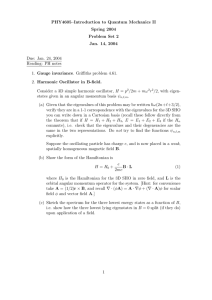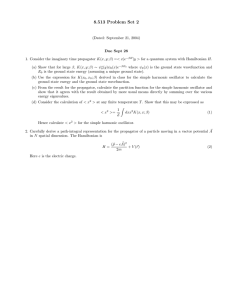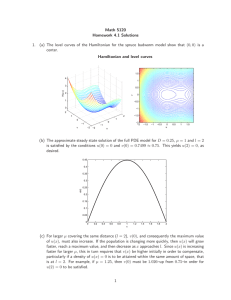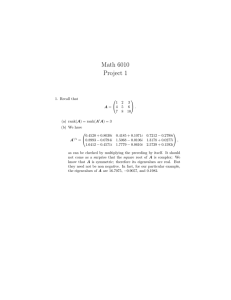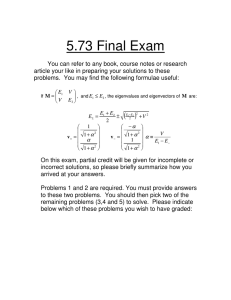5.73 Problem Set 4 ψ
advertisement
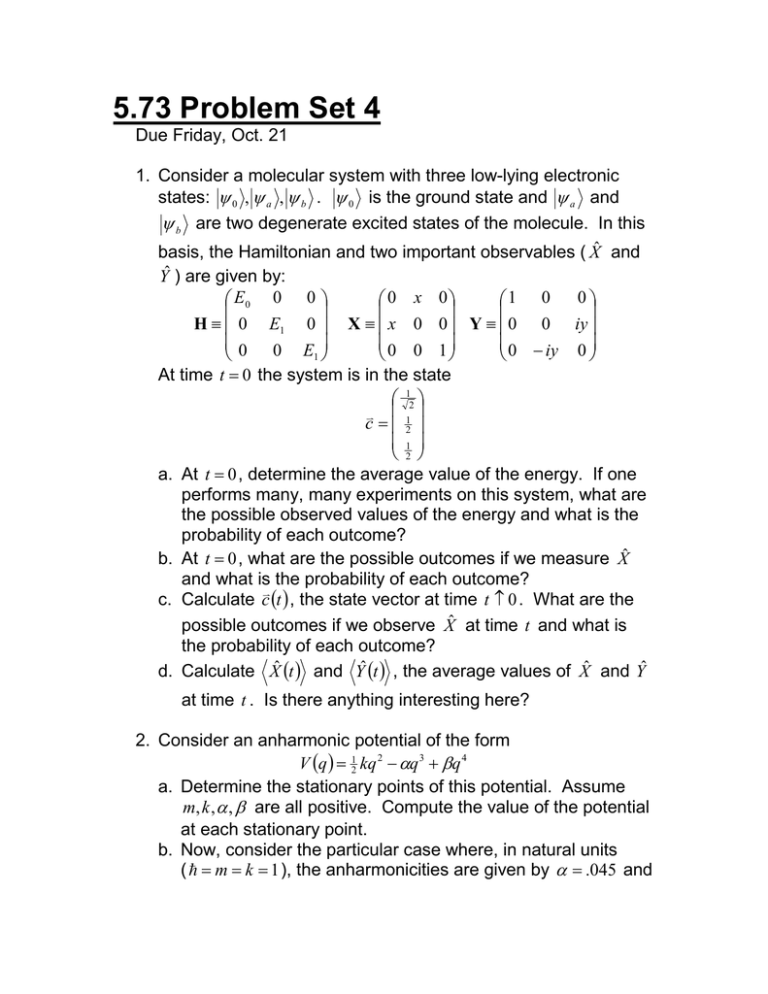
5.73 Problem Set 4 Due Friday, Oct. 21 1. Consider a molecular system with three low-lying electronic states: ψ 0 , ψ a , ψ b . ψ 0 is the ground state and ψ a and ψ b are two degenerate excited states of the molecule. In this basis, the Hamiltonian and two important observables ( X̂ and Yˆ ) are given by: 0 E0 0 0 0 x 0 1 0 H ≡ 0 E1 0 X ≡ x 0 0 Y ≡ 0 0 iy 0 0 E 0 0 1 0 − iy 0 1 At time t = 0 the system is in the state 12 c = 12 1 2 a. At t = 0 , determine the average value of the energy. If one performs many, many experiments on this system, what are the possible observed values of the energy and what is the probability of each outcome? b. At t = 0 , what are the possible outcomes if we measure X̂ and what is the probability of each outcome? c. Calculate c (t ) , the state vector at time t ≠ 0 . What are the possible outcomes if we observe X̂ at time t and what is the probability of each outcome? d. Calculate X̂ (t ) and Yˆ (t ) , the average values of X̂ and Yˆ at time t . Is there anything interesting here? 2. Consider an anharmonic potential of the form V (q ) = 12 kq 2 − αq 3 + βq 4 a. Determine the stationary points of this potential. Assume m, k , α , β are all positive. Compute the value of the potential at each stationary point. b. Now, consider the particular case where, in natural units ( = m = k = 1 ), the anharmonicities are given by α = .045 and β = .00107 . Plot this potential and note any important features. c. Use DVR to determine the lowest 25 eigenvalues of this potential. Note that you will probably need many more than 25 states to ensure that the lowest 25 eigenvalues are accurate. d. Determine which of the 25 eigenstates are located to the left and right of the barrier. This may be done by examining appropriate average values (e.g. ψ n qˆ ψ n , ψ n qˆ 2 ψ n , etc.) for each state. How well-localized are the states to the right of the barrier? e. Fit the energies of the lowest several states localized on the left to a standard vibrational expansion: 2 3 E (n ) = E0 + ωe (n + 12 ) − ωe xe (n + 12 ) + ωe ye (n + 12 ) where n is the quantum number that numbers the levels. What happens if you try to fit all 25 of the lowest states to this expansion? 3. This problem shows how more complicated (but still exactly solvable) problems often turn out to be the Harmonic Oscillator in disguise. These ideas arise from a field called supersymmetric quantum mechanics. Consider the generalized creation and destruction operators: Aˆ = ( f (qˆ ) + i 12 pˆ ) and Aˆ † = ( f (qˆ ) − i 12 pˆ ) a. Compute the commutator Aˆ † , Aˆ . [ ] b. Construct the harmonic oscillator-like Hamiltonian Hˆ + = Aˆ † Aˆ . Show that the effective potential is given by: 1 df (q ) V + (q ) = f 2 (q ) − . 2 dq ˆ ˆ † . What is the c. Construct the related Hamiltonian Hˆ − = AA effective potential in this case? Hˆ + and Hˆ − are said to be supersymmtric partners. d. Denote the eigenstates of Hˆ + , Hˆ − by Hˆ + ψ n+ = En+ ψ n+ and Hˆ − ψ n− = En− ψ n− Show that Aˆ † ψ n− is proportional to an eigenfunction of Hˆ + . What does this imply about the eigenvalues of Hˆ − ? What is the normalization constant for Aˆ † ψ n− ? [Hint: you will want to exploit the analogy with the Harmonic oscillator] e. Consider the specific case f (qˆ ) = αe − βqˆ + γ . Plot the effective potentials for Hˆ + and Hˆ − . Could either of these be useful? Show that: V + (qˆ;α , β , γ ) = V − (qˆ;α ' , β ' , γ ' ) + R (α , β , γ ) That is, show that Hˆ + and Hˆ − are of the same form, just with the parameters α , β , γ changed and a constant, R , added. This property is called shape invariance, and is crucial to determining the eigenvalues of Hˆ + and Hˆ − . f. Use the results of parts d. and e. to determine the lowest two eigenvalues of Hˆ + (α , β , γ ) in the following way: Use part d. and the analogy with the Harmonic oscillator to determine the ground state energy of Hˆ + (α , β , γ ) . Next, use part e. to determine the ground state energy of Hˆ − , which will be related to an excited state energy of Hˆ + . g. Determine the lowest two eigenvalues of the Morse Hamiltonian: pˆ 2 2 + Ĥ = + D (1 − exp( − β (q − q0 )) 2 by showing that the Morse potential corresponds to a particular choice of α , β , γ . Put your results in the standard vibrational form: 2 E (n ) = ωe (n + 12 ) − ωe xe (n + 12 ) . What is the relationship between α , β , γ and ωe , xe ?
